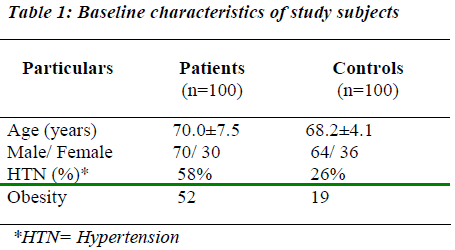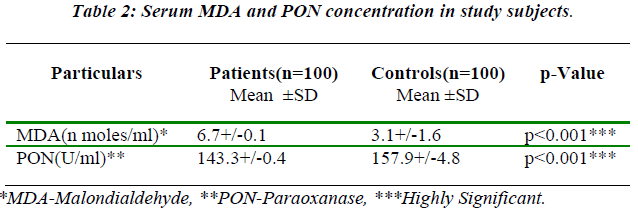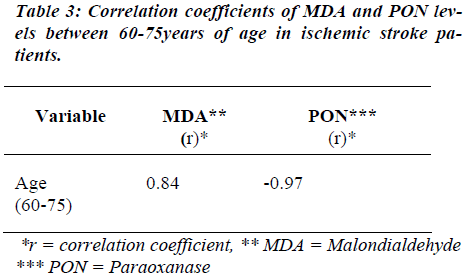ISSN: 0970-938X (Print) | 0976-1683 (Electronic)
Biomedical Research
An International Journal of Medical Sciences
- Biomedical Research (2009) Volume 20, Issue 1
A study of serum malondialdehyde levels and paraoxanase activity in ischemic stroke patients
Stroke is the leading cause of mortality and morbidity world wide, particularly in the eld-erly. Oxidative stress is an independent risk factor by inducing production of oxygen free radicals in ischemic stroke. Because a relationship may be hypothesized between paraox-anase (PON) and malondialdehyde(MDA),the aim of this study was to investigate the rela-tionship between PON and oxidative stress with ischemic stroke by evaluating MDA concen-trations as indexes of oxidative stress. Our study included 100 patients of ischemic stroke and 100 controls.MDA levels was high and antioxidant activity Of PON was low in patients with ischemic stroke as compared to controls. Our findings suggest the importance of assess-ing the markers of oxidative stress and antioxidant capacity of PON indicating the involve-ment of lipid peroxidation leading to ischemic stroke.
Keywords
Lipid peroxidation, Ischemic stroke, Oxidative stress, Paraoxanase.
Introduction
The term stroke defines rapidly developing clinical symp-toms and signs of focal loss of cerebral function lasting for more than 24 hours leading to death with no apparent cause other than vascular origin. [1) The increasing inci-dence of stroke in Indian patients (>65 years) is possibly due to industrialization, stress of life, less exercise, in-creasing incidence of smoking, hypertension and other factors. Oxidative stress is one of the mechanisms invol-ved in neuronal damage induced by ischemia and reperfu-sion probably due to lipid peroxidation.[2]. Malondialde-hyde (MDA) which is widely used as an index of oxida-tive damage ,has received particular attention in pharma-cologic studies for its ability to interact with lipoproteins. These modified lipoproteins are taken up by macrophages and transformed into foam cells that contribute to athero-sclerotic plaque development and progression of athero-genesis [3].
Serum Paraoxanase [(E.C3.1.8.3) aryl alkyl phosphate] is a protein of 354 aminoacids(molecular mass 43kDa) syn-thesized in the liver that prevents oxidative modification of low density lipoprotein (LDL).Serum PON is responsi-ble for antioxidant activity of high density lipoprotein (HDL) [4]. Because a relationship may be hypothesized between PON and MDA, the aim of this study was to inv-estigate the relationship between PON and stress in ischemic stroke patients by evaluating MDA concentra-tions as indexes of oxidative stress.
The study was case controlled in design. We have se-lected the patients as they have presented. Patients in-cluded in the present study were all admitted to the Inten-sive Care Unit (ICU) or attending the outpatient depart-ment of Medicine of Maharaja Yashvantrao Hospital atta-ched to Mahatma Gandhi Memorial College, Indore (M.P).
The study group consisted of 100 patients with ischemic stroke between 60-75 years of age and they were under-going admission to hospital and 100 age and sex matched controls were taken with no family history of stroke. Brief clinical history covering the signs and symptoms, past, personal and family history of concerned risk factors were taken. All participants gave written informed consent and this protocol was approved by ethical and research com-mittee of Mahatma Gandhi Memorial Medical College, Indore.Table-1 gives the details of the profiles of the sub-jects The study was case controlled in design. We have selected the patients as they have presented. Patients in-cluded in the present study were all admitted to the Inten-sive Care Unit (ICU) or attending the outpatient depart-ment of Medicine of Maharaja Yashvantrao Hospital at-tached to Mahatma Gandhi Memorial College, Indore (M.P), India
The study group consisted of 100 patients with ischemic stroke between 60-75 years of age and they were under-going admission to hospital and 100 age and sex matched controls were taken with no family history of stroke. Brief clinical history covering the signs and symptons, past, personal and family history of concerned risk factors were taken. All participants gave written informed consent and this protocol was approved by ethical and research com-mittee of Mahatma Gandhi Memorial Medical College, Indore.Table-1 gives the details of the profiles of the subjects.
Venous blood samples were collected from all the study subjects after an overnight fast. Serum levels of MDA, a marker of lipid peroxidation were measured by thiobarbi-turic acid (TBA) method [5]. Serum PON activity was measured by using 5.5mM/L p-nitrophenyl acetate (Sigma chemicals, USA) as a substrate ,the increase in the absorbance of p-nitrophenol formed at 412nm was meas-ured by using ELICO spectrophotometer.[6]. The activity of PON was measured in 20mM/L tris buffer at pH8.0 and which contains 1mM calciumchloride. The generated product of p-nitrophenol was calculated by using molar extinction coefficient of 17000 per mole per cm at pH 8.0.Results are expressed as U/ml (1U), 1nmol p-nitro-phenol formed per minute).
Stastical Analysis
All values are presented as mean+/-s.d. Statistical signifi-cance was analysed by student ‘t’ test and correlation between variables were studied by using Pearson’s corre-lation coefficient test. The level of significance was set at p<0.05.
Results
The clinical characteristics of ischemic stroke patients and control subjects are presented in Table no1.Among 100 ischemic stroke patients, 70% were males and 30% were females. Among 100 controls 64 were males and 36 were females. There are 52 patients with obesity and only 19 subjects among controls were obese and they are statisti-cally significant (p<0.001). Among 100 ischemic stroke patients 58% had the history of hypertension and 26% in control group which was statically significant (p<0.001).
As indicated in Table 3 a positive correlation was found between MDA and PON levels with age.
Discussion
The study was conducted on 100 confirmed cases of ischemic stroke patients and 100 age and sex matched controls. Lipid peroxidation is a well established mecha-nism of cellular injury in humans and is used as an indica-tor of oxidative stress in cells and tissues. There is in-volvement of free radicals and lipid peroxidation in the pathopysiology of stroke [7]. It is suspected that increased level of lipid peroxides may be due to oxidation of blood or neural lipids by ischemia. Brain nucleic acids may be metabolized to purine and nucleoside bases resulting in excess of adenosine which then becomes substrate for xanthine oxidase pathways that are important in genera-tion of free radicals.[8] The involvement of lipid peroxidation in ischemic stroke was confirmed by the signifi-cantly higher concentration of MDA observed in our ischemic stroke patients compared with controls. This increased level is because those lipid peroxidation prod-ucts are a key mediator of apoptosis induced by oxidative stress and antioxidants that suppress lipid peroxidation have been shown to protect against apoptosis induced by oxidative insults. Similar results have been reported by Linnik [9]
Therefore oxidative stress activates phospholipases, pro-teases leading to conversion of xanthine dehydrogenase to xanthine oxidase or activates protein kinases causing free radical production.
Significantly lower PON activties have been reported af-ter ischemic stroke when compared with age and gender controls. Decreased serum activity has been reported with other states associated with increased atherosclerosis in-cluding ischemic stroke and renal diseases. Therefore PON activity may reflect the antioxidant and antiathero-genic capacity [10]..
In conclusion we noted significantly lower mean serum PON activity and increased MDA levels in patients with ischemic stroke. We hypothesis that reduced PON activity and increased MDA level may contribute to the increased susceptibility for the development of oxidative stress. Ischemic stroke is associated with an imbalance between oxidant levels and antioxidant defense mechanism. Fur-ther prospective studies with large sample sizes are war-ranted to evaluate the relationship between reduced PON activity and elevated MDA levels in patients with ischemic stroke. The present study confirms that there is an elevated oxidative stress, reduced PON activity in ischemic stroke patients and emphasizes the importance of assessing these markers for early diagnosis and thera-peutic interventions.
References
- Bronner LL, Kanter DS: Primary prevention of stroke. N Engl J Med 1995; 333: 1392-1400.
- Dalal PM.Ischaemic strokes, Management in first six hours.Neurol India 2001; 49: 104-115.
- Demopoulos HB, Hamm ES. The free radical pathol- ogy and microcirculation in major CNS disorders. Acta Physiolo Scand Suppl 1980; 492: 91-113.
- Gan KN, Smolen A, Eckerson HW. Purification of hu- man serum paraoxanase / arylesterase.Evidence for one esterase’s catalyzing both activities. Drug Metab Dispos 1991; 19: 100-106.
- Linnik MD, Hatfield MD. Evidence supporting a role for programmed cell death in focal cerebral ischemia. Stroke 1993; 24: 2002-2008.
- Beg M, Ahmad S, Gandhi S, Akhtar NN. A study of serum malondialdehyde levels in patients of cere-brovascular accident. JIACM 2005; 6: 229-231.
- Mack ness MI, Durrington NP. Human serum paraox- anase. Gen Pharmacol 1998; 31: 329-336.
- Mack ness MI, Mack ness B, Durrington PN. Paraox- anase and coronary heart disease. Atheroscler Suppl 2002; 3:49-55.
- Cavalca V, Cighetti G, Loaldi A etal. Oxidative stress and homocysteine in coronary artery disease. Clin Chem. 2001; 47: 887-892
- Yagi K. Lipid peroxides and human diseases. Chem. Phys Lipids 1987; 45: 337- 351.


